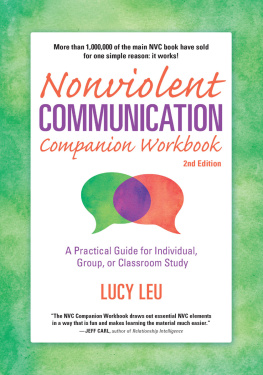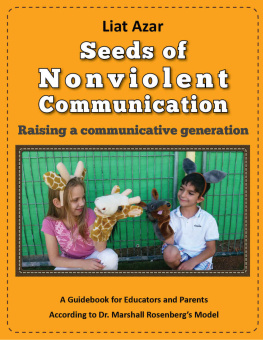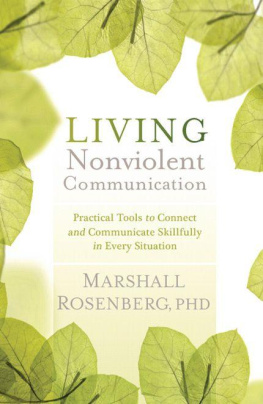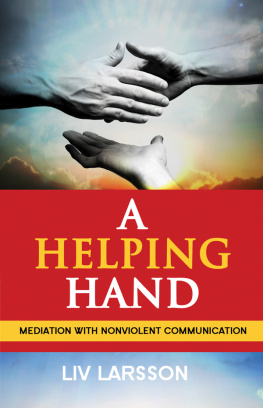Psychologist Marshall B. Rosenberg explains how to express your needs and feelings in ways that promote respectful, empathic interpersonal connections. Hes not writing primarily about conflict resolution or mediation, though you can apply his system of Nonviolent or Compassionate Communication (NVC) in those areas. Instead, he addresses compassionate communication. Rosenbergs updated manual this is the third edition offers new communication-related behaviors you can apply productively. Note that using this system requires embracing a theoretical framework about human needs and emotions that Rosenberg could have explained more completely and youll have to work through some jargon, albeit kind and purposeful. getAbstract recommends this compassionate method to businesspeople seeking clearer communication and those interested in mindfulness, relationships and personal growth.
Summary
Nonviolent Communication
Many of your established communication patterns may contribute to dysfunctional relationships, misunderstandings and frustration. Making moralistic judgments about other people can alienate them. This differs from making value judgments, which people do all the time. Comparing people to each other interferes with authentic communication, as does talking about what someone deserves or denying responsibility for your actions. When you say you have to do something, or someone else is making you do it, you alienate yourself from other people.
Nonviolent or Compassionate Communication (NVC) is a way of communicating that leads us to give from the heart.
Nonviolent or Compassionate Communication (NVC) offers interpersonal connection from the heart. NVC helps you focus and stay humane in tough circumstances. Using NVC, you can alter your consciousness so that you see your actions differently.
NVC has four components: observations, feelings, needs and requests. To apply NVC, work through these four elements. Observe whats going on. Share how an event makes you feel and what you need. If you ask the other person to do something, your request should be specific. Ask for something the person can do. Dont request an attitude change or an abstract intention. NVC has two parts or sides. In one, you express yourself and your reality honestly by working through the four components. In the other, you receive communication and respond with empathy as you and your counterpart(s) work through NVCs four constituent parts. You can apply NVC to personal relationships within families, in business and in group or societal conflicts.
Observation
Separate observation from evaluation. What you notice should be specific to a particular time and context. Avoid using words like never or frequently unless you tie them to specific observations. Rather than using time-based words like these, cite the number of instances of the behavior youve observed. To do a better job of separating evaluation and observation, review the statements you intend to offer, and identify any evaluations you attach to them.
Identifying and Expressing Feelings
Knowing what you feel is valuable, but people wont generally support you in developing that insight. Often, you might not know what they feel either even with members of your family. To get better at the practice of identifying what you feel, distinguish between emotions and thoughts. If you can replace I feel in a statement with I think, you may need to work harder to identify your emotions. Likewise, if you follow the statement I feel with someones name or the word that, youre probably intellectualizing an emotion or presenting an evaluation as a feeling.
First, we observe what is actually happening in a situation: What are we observing others saying or doing that is either enriching or not enriching our life?
Something another person does or says can be the stimulus for what you feel, but its never the cause of your feelings. Your feelings result from how you receive others actions and statements which is, in fact, a choice you make in combination with what you need and expect at that moment. If someone says something negative to you, you have four response options: You can blame yourself. You can blame others. You can pay attention to what you feel and need, or you can pay attention to what others feel and need. Thinking through these options will help you become aware of whats happening, what people are feeling and why. This is a valuable step toward identifying the needs at the root of what you feel and what other people feel.
Identifying Needs
Most people lack experience identifying what they need. You might have learned to criticize others when your needs arent met. For example, if you want a clean, well-organized home, you might nag someone in your family for leaving a coat out, without ever recognizing your deeper need for clear spaces. This happens in large-scale conflicts or in disagreements between workers and business owners. Rather than identifying what they need, people hurl accusations labeling others and their actions.
When we simply express our feelings, it may not be clear to the listener what we want them to do.
You have physical needs, like food and water. You have spiritual needs, like beauty and harmony. Some needs relate to autonomy and integrity, like being able to choose your values or create your vision. Others spring from interdependence, like community, acceptance and appreciation. Before anyone else can value your needs, you must acknowledge and value them yourself. Identifying your needs is an important step in a larger journey of emotional liberation. This odyssey has three main stages: First, you experience emotional slavery, when you feel responsible for what others feel. Second comes the obnoxious stage, when you reject that responsibility. You know what you arent responsible for, but you dont yet know how to respond to what others feel. In the third stage, emotional liberation, you take responsibility for your intentions and your actions.
Ask for What You Need
NVCs fourth component is requesting, that is, asking other people for things that would enrich your life. Use active language when you make a request. Be specific and positive. Dont ask people not to do something. Ask them to take specific positive actions. Dont ask your spouse not to spend as much time at work or not to treat you disrespectfully. Ask, instead, to share more intimate time or to look into your eyes and listen when you talk to each other. If you just express your feelings, your listener might not realize what you want or that you want anything at all.














